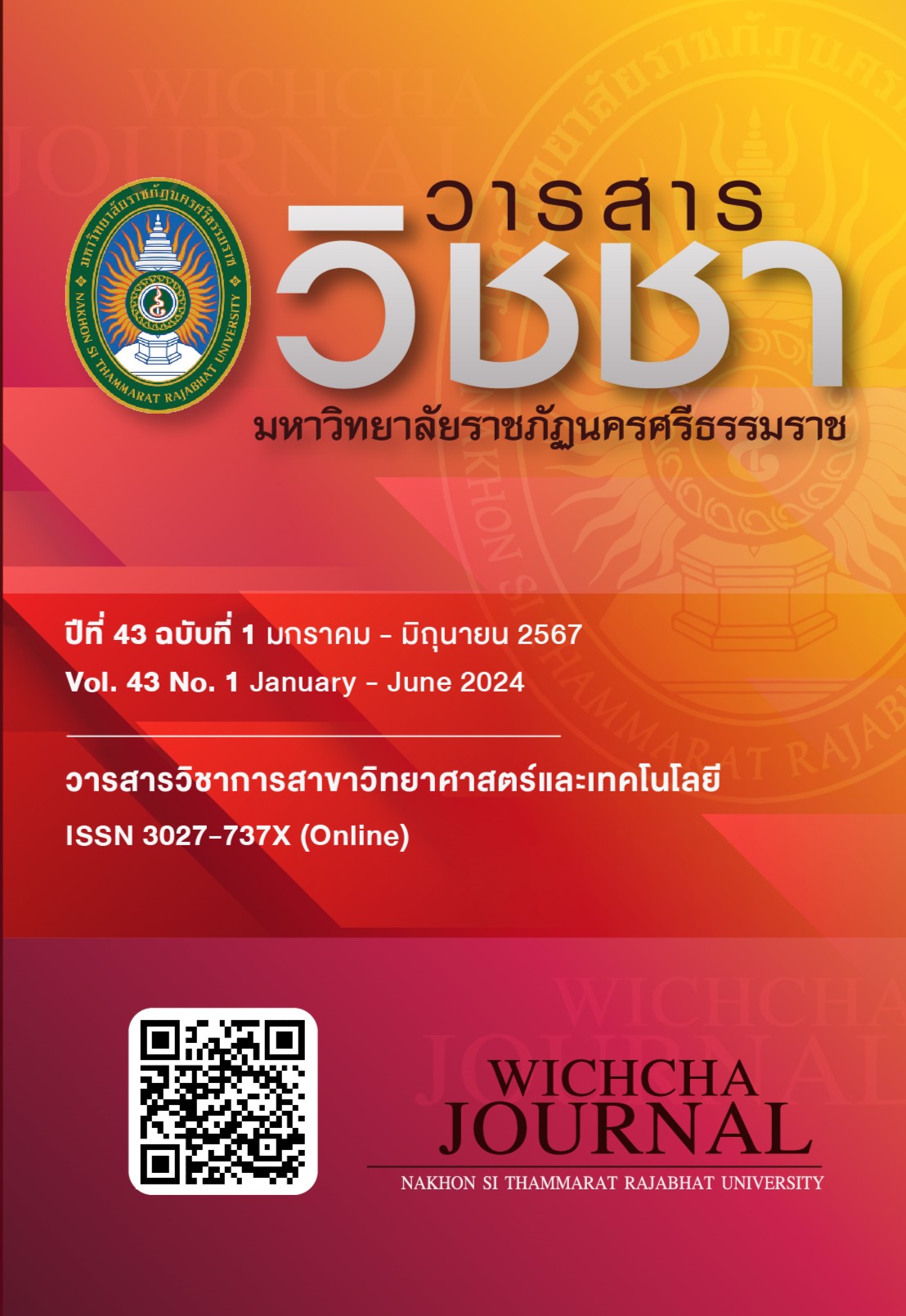Total Phenolic Compounds and Cytotoxicity in Brine Shrimp and Aedes aegypti Larvae of Thurian-thet (Annona muricata L.) Crude Extracts
Main Article Content
Abstract
This research was conducted to determine total phenolic compounds and assess cytotoxicity in brine shrimp and Aedes aegypti larvae of crude extracts from various parts of Thurian-thet: unripe fruit, ripe fruit, leaves, seeds and stem bark achieved by adopting different solvents which are hexane, dichloromethane, ethanol, and methane. The maximum phenolic content was found in ethanolic ripe fruit extract at 2,036±5.99 microgram of gallic acid equivalent per milligram of extract (µg GAE/g ext). The crude extracts at concentrations of 10-1,000 microgram per milliliter (µg/mL) were tested for cytotoxicity in brine shrimp and Aedes aegypti larvae. It was found that the lowest lethal concentration fifty (LC50) tested in brine shrimp was 71.95 µg/mL (24 h) from methanolic ripe fruit extract and in mosquito larvae was 21.39 µg/mL (24 h) from ethyl alcoholic ripe fruit extract. The results suggested that the ethanolic ripe fruit extract contained the maximal total phenolic compounds which could be used as natural antioxidants. The ethanolic ripe fruit extract could also be used as a mosquito natural repellent since after being tested with mosquito larva and found the lowest value of LC50. However, the toxicity tests of Thurian-thet ripe fruit extract in laboratory animals should be determined in the future for possible applications in food and medicine.
Article Details

This work is licensed under a Creative Commons Attribution-NonCommercial-NoDerivatives 4.0 International License.
เนื้อหาและข้อมูลในบทความที่ลงตีพิมพ์ในวารสารวิชชา มหาวิทยาลัยราชภัฏนครศรีธรรมราช ถือเป็นข้อคิดเห็นและความรับผิดชอบของผู้เขียนบทความโดยตรง ซึ่งกองบรรณาธิการวารสารไม่จำเป็นต้องเห็นด้วยหรือร่วมรับผิดชอบใด ๆ
บทความ ข้อมูล เนื้อหา รูปภาพ ฯลฯ ที่ได้รับการตีพิมพ์ในวารสารวิชชา มหาวิทยาลัยราชภัฏนครศรีธรรมราช ถือเป็นลิขสิทธ์ของวารสารวิชชา มหาวิทยาลัยราชภัฏนครศรีธรรมราช หากบุคคลหรือหน่วยงานใดต้องการนำข้อมูลทั้งหมดหรือส่วนหนึ่งส่วนใดไปเผยแพร่ต่อหรือเพื่อการกระทำการใด ๆ จะต้องได้รับอนุญาตเป็นลายลักษณ์อักษรจากวารสารวิชชา มหาวิทยาลัยราชภัฏนครศรีธรรมราชก่อนเท่านั้น
The content and information in the article published in Wichcha journal Nakhon Si Thammarat Rajabhat University, It is the opinion and responsibility of the author of the article. The editorial journals do not need to agree. Or share any responsibility.
References
กามีละห์ ยะโกะ. (2566). ประสิทธิภาพในการต้านอนุมูลอิสระของผักพื้นบ้านในจังหวัดสุราษฎร์ธานี. วารสารวิชชา มหาวิทยาลัยราชภัฏนครศรีธรรมราช, 42(1), 93-103.
วิวัฒน์ พันธวุฒิยานนท์ และนันทสิทธิ์ บุณยะรัตเวช. (2540). ผลไม้พื้นบ้านภาคใต้. วารสารสารคดี, 11(14), 54-72.
Alali, F.Q, Liu, X.X. and McLaughlin, J.L. (1999). Annonaceous acetogenins: Recent progress. Journal of Natural Products, 62(3), 504-540, doi: https://doi.org/10.1021/np980406d.
Baur, F.J., and Ensminger, L.G. (1977). The association of official analytical chemists (AOAC). Journal of American Oil Chemical Society, 54, 171-172, doi: https://doi.org/10.1007/BF02670789.
Ciccia, G., Coussio, J. and Mongelli, E. (2000). Insecticidal activity against Aedes aegypti larvae of some medicinal South American plants. Journal of Ethnophamacology, 72(1-2), 185-189, doi: https://doi.org/10.1016/S0378-8741(00)00241-5.
Hernández-Fuentes, G.A., García-Argáez, A.N., Campos, A.L.P., Delgado-Enciso, I., Muñiz-Valencia, R., Martínez-Martínez, F.J., Toninello, A., Gómez-Sandoval, Z., Mojica-Sánchez, J.P., Via, L.D. and Parra-Delgado, H. (2021). Cytotoxic acetogenins from the roots of Annona purpurea. International Journal of Molecular Science, 20(8), doi: https://doi.org/10.3390/ijms20081870.
Hlywkai, J.J., Bech, M.M. and Bullerman, L.B. (1997). The use of the chicken embryo screening test and brine shrimp (Artemia satina) bioassays to assess the toxicity of fumonisin B1 mycotoxin. Food and Chemical Toxicology Research, 35(10-11), 991-999, doi: https://doi.org/10.1016/s0278-6915(97)87268-7.
Huai, H., Dong, Q. and Lui, A. (2010). Ethnomedicinal analysis of toxic plants from five ethnic groups in China. Ethnobotany Research and Applications, 8, 169-179, doi: https://doi.org/10.17348/era.8.0.169-179.
Jaramillo, M.C., Arango, G.J., González, M.C., Robledo, S.M. and Velez, I.D. (2000). Cytotoxicity and antileishmanial activity of Annona muricata pericarp. Fitoterapia, 71(2), 183-186, doi: https://doi.org/10.1016/S0367-326X(99)00138-0.
Liaw, C.C., Chang, F.R., Lin, C.Y., Chou, C.J., Chiu, H.F., Wu, M.J. and Wu, Y.C. (2002). New cytotoxic monotetrahydrofuran annonaceous acetogenins from Annona muricata. Journal of Natural Products, 65(4), 470-475, doi: https://doi.org/10.1021/np0105578.
Mackeen, M.M., Khan, M.N., Zamadi, Z. and Lajis, N.H. (2000). Brine shrimp toxicity of fractionated extracts of Malaysian medicinal plants. Natural Product Sciences, 6(3), 131-134.
Meyer, B.N., Ferrigni, N.R., Putnam, J.E., Jacobsen, L.B., Nichols, D.E. and McLaughlin, J.L. (1982). Brine shrimp: A convenient general bioassay for active plant constituents. Planta Medica, 45(5), 31-34, doi: https://doi.org/10.1055/s-2007-971236.
Nolasco, Y.G., Chacón-López, M.A., Basurto, R.I.O., Aguirre, S.A., González-Aguilar, G.A., Rodríguez-Aguayo, C., Cortez, M.C.N., Galindo, H.S.G., Magaña, M.L.G., Espinoza, L.M. and González, E.M. (2022). Annona muricata leaves as a source of bioactive compounds: Extraction and quantification using ultrasound. Horticulturae, 8(7), doi: https://doi.org/10.3390/horticulturae8070560.
Oberlies, N.H., Chang, C.J. and McLaughlin, J.L. (1997). Structure-activity relationships of diverse Annonaceous acetogenins against multidrug resistant human mammary adeno-carcinoma (MCF-7/Adr) cells. Journal of Medicinal Chemistry, 40(13), 2102-2106, doi: https://doi.org/10.1021/jm9700169.
Randhir, R., Lin, Y.T. and Shetty, K. (2004). Phenolics, their antioxidant and antimicrobial activity in dark germinated fenugreek sprouts in response to peptide and phytochemical elicitors. Asia Pacific Journal Clinical Nutrition, 13(3), 295-307.
Singelton, V.L., Orthofer, R. and Lamaela-Raventos, R.M. (1999). Analysis of total phenols and other oxidation substrates and antioxidants by means of Folin-Ciocalteau reagent. Method in Enzymology, 299, 152-178, doi: https://doi.org/10.1016/S0076-6879(99)99017-1.
Solis, P.N., Wright, C.W., Anderson, M.M., Gupta, M.P. and Philipson, J.D. (1993). A microwell cytotoxicity assay using Artemia salina (brine shrimp). Planta Medica, 59(3), 250-252, doi: https://doi.org/10.1055/s-2006-959661.
Wilfred, V. and Ralph, N. (2006). Phenolic compound biochemistry. London: Academic Press.


